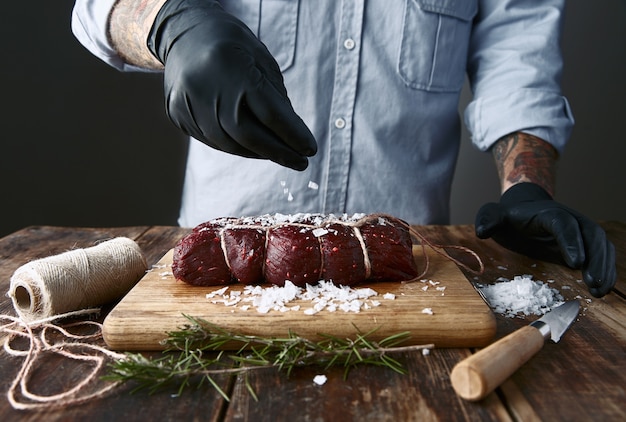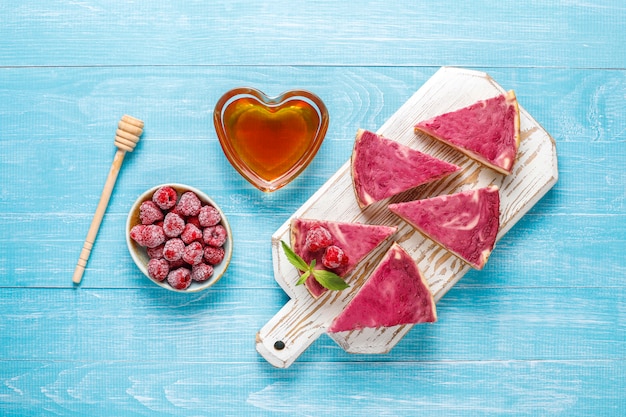Let's be honest, the words "cow heart" might make some people squirm. It's not the most common ingredient on the dinner table, and that's a shame! It's time to shed the fear and embrace this unique cut of meat. Cow heart is a delicious, protein-rich treasure, and it's time for it to get the recognition it deserves.
My journey with cow heart began at a friend's barbecue a few years back. I was a bit hesitant at first – I mean, who eats cow heart, right? But my friend, a culinary adventurer herself, insisted it was fantastic. And she was right! It was tender, flavorful, and honestly, a revelation! It's safe to say I've become a bit of a cow heart convert since then. I'm here to share my knowledge and guide you through the wonderful world of cooking this intriguing cut.
Part 1: Unveiling the Mystery of Cow Heart

Firstly, let's clear up any confusion. Cow heart, as you've probably guessed, comes from, well, the heart of a cow. It's a lean, protein-packed muscle, often used in traditional cuisines around the globe. It's different from your typical steak or roast, offering a unique texture that's both chewy and tender – a fascinating culinary experience.
Finding Your Cow Heart
Now, you're probably thinking, "Where on earth do I find this unusual cut?" Don't worry, it's not as elusive as you might think. Most butchers, especially those specializing in ethnic cuts, will have it in stock. If you're unsure, just ask! They're usually more than happy to help. You might also find it at some Asian supermarkets, particularly those with a good selection of meats.
Preparing Your Cow Heart
Once you have your cow heart, it's time to get down to business and prep it for cooking. The first step is giving it a good clean. Remove any excess fat and connective tissue. Don't be afraid to get your hands a bit dirty! Trim away any large blood vessels or cartilage you find. You can also soak the heart in cold water for 30 minutes to an hour to remove any lingering blood. Once it's clean and prepped, you're ready to cook!
Part 2: Mastering the Art of Cow Heart Cooking

Now, let's get to the exciting part - cooking the cow heart! There are a few excellent methods, each delivering unique flavor and texture. Let me guide you through some of my favorites:
Braising: A Symphony of Flavors
This is my go-to method for cow heart. It's incredibly simple and produces a wonderfully tender and flavorful result. Here's the recipe breakdown:
- Cut your cow heart into bite-sized pieces. This ensures even cooking and allows the flavors to penetrate deeply.
- Season the pieces generously with salt, pepper, and any spices you enjoy. I typically use a blend of paprika, garlic powder, and onion powder for a touch of warmth and depth. But feel free to experiment!
- Sear the heart pieces in a pan over medium heat until browned on all sides. This adds richness and intensifies the flavor.
- Transfer the browned heart pieces to a dutch oven or a large pot with a lid. Add your favorite braising liquid, like beef broth, red wine, or even beer. For extra flavor and sweetness, throw in some vegetables like onions, carrots, and celery.
- Bring the pot to a simmer, cover it, and cook for at least 2 hours, or until the heart is fork-tender. The slow cooking allows the connective tissues to break down and the flavors to meld beautifully.
- Once the heart is cooked, remove it from the braising liquid and shred it using two forks or a food processor. You can thicken the braising liquid with cornstarch or flour for a delicious gravy to serve over your shredded heart.
Braised cow heart is a symphony of flavors, absolutely delicious served over rice, mashed potatoes, or even used in tacos, burritos, or stews. It's a culinary journey worth taking!
Stewing: A Hearty and Comforting Dish
Another fantastic way to cook cow heart is by stewing it. The process is similar to braising, but typically uses less liquid and a shorter simmering time. Here's how to create a hearty stew:
- Cut the cow heart into cubes and brown them in a large pot. Add your favorite stew vegetables like carrots, potatoes, and onions. I like to add a bit of tomato paste to my stew for an extra layer of depth.
- Pour in your chosen stew liquid – beef broth, chicken broth, or even water works well. Season it generously with salt, pepper, and your favorite herbs. Classic options include bay leaves, thyme, and rosemary.
- Bring the pot to a simmer, cover it, and cook for 1-2 hours until the cow heart is tender and the vegetables are cooked through. Stir the stew occasionally to prevent sticking and allow the flavors to develop evenly.
Stewed cow heart is a hearty and comforting dish, perfect for a chilly evening. Serve it with crusty bread, a side of salad, or a dollop of sour cream. It's a warming embrace in a bowl.
Frying: A Quick and Savory Bite
For a quicker, more casual approach, frying is another excellent option for cow heart. This method works best with thin slices of heart and results in a crispy, flavorful bite. Here's how to do it:
- Cut the cow heart into thin slices, about 1/4 inch thick. If you're using a thick piece of heart, you can pound it with a meat mallet to tenderize it before slicing. This will make it easier to cook through.
- Season the slices generously with salt, pepper, and any other spices you like. A simple combination of salt, pepper, and garlic powder is always a good choice.
- Heat some oil in a pan over medium heat. Add the heart slices to the hot oil and cook for about 2-3 minutes per side, or until they're golden brown and cooked through. Avoid overcrowding the pan; otherwise, the temperature will drop, and the heart won't cook evenly.
Fried cow heart is delicious served with a dipping sauce, like aioli or chimichurri. It can also be added to stir-fries, tacos, or other dishes where you're looking for a crispy and savory addition.
Part 3: Tips and Tricks to Enhance Your Cow Heart Cooking

Now, let's dive into some practical tips and tricks to elevate your cow heart cooking game. These are things I've learned along the way, and they can make a significant difference in the final outcome:
Don't Overcook It!
Cow heart is lean, and it can become tough and dry if overcooked. Keep a close eye on it while it's cooking, and remove it from the heat as soon as it's cooked through. The internal temperature should reach 145 degrees Fahrenheit for safe consumption. If you're unsure, use a meat thermometer.
Slow and Steady Wins the Race
One of the keys to success with cow heart is slow cooking. It allows the connective tissues to break down, resulting in a tender and flavorful dish. Be patient and let it simmer or braise for the recommended time. It's worth the wait!
Seasoning is Key
As with any cut of meat, seasoning is crucial to enhance the flavor of cow heart. Don't be afraid to get creative with your spices and herbs. I like to use a combination of paprika, garlic powder, onion powder, and cumin for a slightly smoky flavor. Experiment and find what you enjoy! A sprinkle of dried oregano or thyme can add a lovely herbal touch.
Don't Be Afraid to Experiment
Remember, there are no strict rules when it comes to cooking cow heart. Feel free to experiment with different flavors and cooking methods. Add vegetables, fruits, or a splash of wine or vinegar to your dish. Let your culinary imagination run wild!
Part 4: Understanding the Nutritional Value and Health Benefits
Now, let's talk about the health aspects of this unique meat. Cow heart is a lean protein source, packed with essential nutrients like iron, zinc, and B vitamins. Here's a breakdown of some of its key nutritional benefits:
Protein Powerhouse
Cow heart is a fantastic source of protein, vital for building and repairing tissues, and also plays a role in maintaining a healthy immune system. One serving of cow heart can provide a significant portion of your daily protein needs.
Iron Rich
Iron is an essential mineral that helps carry oxygen throughout the body. Cow heart is a good source of iron, making it a valuable choice for those prone to iron deficiency.
Zinc for a Healthy Body
Zinc is another essential mineral that plays a crucial role in immune function, wound healing, and cell growth. Cow heart is a good source of zinc, and incorporating it into your diet can help you meet your daily requirements.
B Vitamins for Energy and Function
B vitamins are essential for energy production, cell function, and maintaining a healthy nervous system. Cow heart is a good source of several B vitamins, including vitamin B12, which is not found in many plant-based foods.
It's worth noting that cow heart is a rich source of cholesterol. If you have concerns about your cholesterol levels, it's a good idea to talk to your doctor before adding cow heart to your diet.
Part 5: Exploring the Cultural Significance and Culinary Traditions
Cow heart is a beloved ingredient in many cultures around the world, and its culinary traditions vary widely. Let's take a peek at some of the ways this unique cut is celebrated in different cuisines:
Mediterranean Delights
In Mediterranean cuisine, cow heart is often braised or stewed with vegetables and spices. It's a popular ingredient in Greek and Turkish dishes, often served with a side of rice or pita bread.
Asian Culinary Treasures
Cow heart is also a popular ingredient in Asian cuisines. In China, it's often stir-fried with vegetables and spices. In Vietnam, it's used in a variety of soups and stews. And in Korea, it's often grilled with a spicy sauce.
Latin American Flavors
Latin American cuisine also embraces cow heart. In Mexico, it's often used in tacos, burritos, and other street food. In Peru, it's used in a traditional dish called "corazón de res" (beef heart), which is braised with aji panca peppers and other spices.
Part 6: Comparing Cow Heart to Other Cuts of Beef
You might be wondering how cow heart compares to other, more familiar cuts of beef. Let's take a closer look at its characteristics and how it differs from other popular options:
Texture: A Unique Culinary Experience
The texture of cow heart is unique and different from other cuts of beef. It's quite chewy and has a slightly firmer texture than, say, a tenderloin or a ribeye. But with the right cooking method, it can be incredibly tender and flavorful. The long cooking times used for braising and stewing help to break down the tough connective tissues and create a melt-in-your-mouth texture.
Flavor: A Distinctive Depth
Cow heart has a distinctive flavor that's slightly gamier and richer than other cuts of beef. It's not as sweet as a sirloin or as buttery as a rib-eye. But when cooked properly, its flavour can be incredibly complex and satisfying.
Nutritional Value: Lean and Nutrient-Rich
Cow heart is leaner than many other cuts of beef, which means it's lower in fat and calories. It's also a good source of protein, iron, and other essential nutrients. However, it is higher in cholesterol than other lean cuts.
Part 7: Sustainable Consumption and Ethical Sourcing
As with any meat, it's important to consider the sustainability and ethical sourcing of cow heart. Here are some things to keep in mind:
Sustainable Farming Practices
Look for cow heart from farms that practice sustainable farming practices. This means they focus on minimizing their environmental impact and promoting animal welfare. Look for certifications like "grass-fed" or "organic" to ensure that the meat you're buying comes from a farm that adheres to responsible practices.
Ethical Sourcing: Choosing Compassionate Meat
Choose cow heart from sources that prioritize animal welfare. Look for farms that treat their animals humanely and provide them with a good quality of life. You can also look for labels that indicate the meat has been sourced ethically, like "humane" or "free-range."
Waste Reduction: Using What We Have
By utilizing cow heart, you're helping to reduce food waste. This cut is often overlooked, but it's a delicious and nutritious ingredient that deserves a place on our plates. By choosing it, you're supporting the sustainable use of resources.
Part 8: FAQs: Addressing Your Cow Heart Questions
Let's address some common questions about cow heart. I've put together a list of the most frequently asked questions, along with detailed answers to help you feel more confident about cooking and enjoying this unique cut:
1. Does Cow Heart Taste Gamey?
Cow heart can have a slightly gamier flavour than other cuts of beef. However, the flavour can be minimized by using proper cooking techniques. Braising or stewing the heart with aromatics and spices can help to mask any gamey taste and create a more palatable flavour profile. It's also important to choose high-quality meat from a reputable source. The fresher the meat, the less intense the gamey flavor.
2. Is Cow Heart Tough?
Cow heart can be tough if it's not cooked properly. However, with the right cooking method, it can be incredibly tender. The key is to cook it slowly and allow the connective tissues to break down. Braising, stewing, and slow-cooking methods are particularly effective for tenderizing cow heart. Avoid overcooking, as this can make it tough and dry.
3. How Can I Tell If Cow Heart is Cooked Through?
You can tell if cow heart is cooked through by using a meat thermometer. The internal temperature should reach 145 degrees Fahrenheit for safe consumption. If you don't have a thermometer, you can check the texture. The heart should be firm and springy to the touch, and the juices should run clear, not pink. If it's still pink or has a raw texture in the center, it needs to be cooked longer.
4. Can I Freeze Cow Heart?
Yes, you can freeze cow heart. It's best to freeze it whole or in large pieces to minimize freezer burn. Wrap it tightly in plastic wrap or aluminum foil before placing it in a freezer bag. It can be frozen for up to 3 months. To thaw frozen cow heart, place it in the refrigerator overnight. Do not thaw it at room temperature, as this can promote bacterial growth.
5. What are Some Creative Ways to Use Cow Heart?
Cow heart can be used in a variety of dishes. It's delicious braised, stewed, or fried. You can also add it to soups, stews, tacos, burritos, and other dishes where you're looking for a hearty and flavorful ingredient. Be creative and experiment with different flavors and cooking methods to find your favorite ways to use cow heart.
Conclusion: Embracing the Culinary Adventure
There you have it! I hope you've found this guide helpful and that you're now feeling inspired to try cooking cow heart. It's a truly unique cut of meat that deserves a place on your table. Don't be afraid to get outside your comfort zone and explore the world of culinary adventure! Give it a go, and you might just discover your next favorite dish. Happy cooking!
Everyone is watching

Corn on the Cob: The Ultimate Guide to Perfectly Cooked Ears
Healthy MealsAh, corn on the cob. Just the name evokes images of sunny days, barbecues, and that sweet, juicy flavour that ...

Scallops: The Ultimate Guide to Perfect Cooking
Healthy MealsAh, scallops. Those delicate, sweet, and utterly delicious morsels of the sea. They hold a special place in my...

Spaghetti Squash: The Ultimate Guide to Cooking and Serving
Healthy MealsRemember that time you saw spaghetti squash at the supermarket, looking all bumpy and strange, and thought, "W...

Salmon Cooking Times: Perfect Guide for Every Recipe
Healthy MealsLet me tell you, cooking salmon is an art form. It's all about getting that perfect balance: juicy and tender,...

Ham Cooking Time: How Long to Bake, Smoke, or Boil a Delicious Ham
Healthy MealsAh, ham. It's a classic, isn't it? A real crowd-pleaser, especially around holidays. And when done right, it'...
